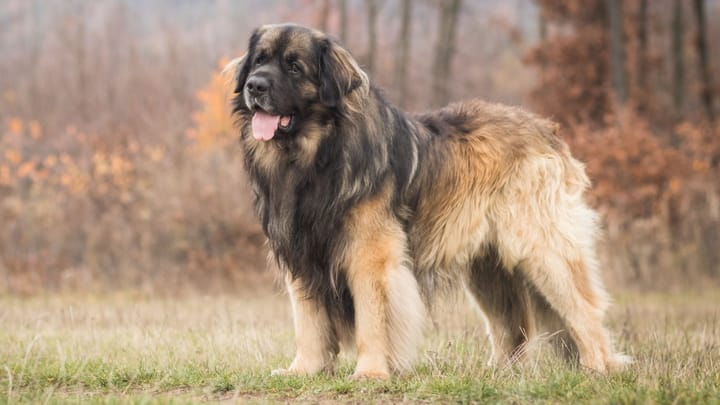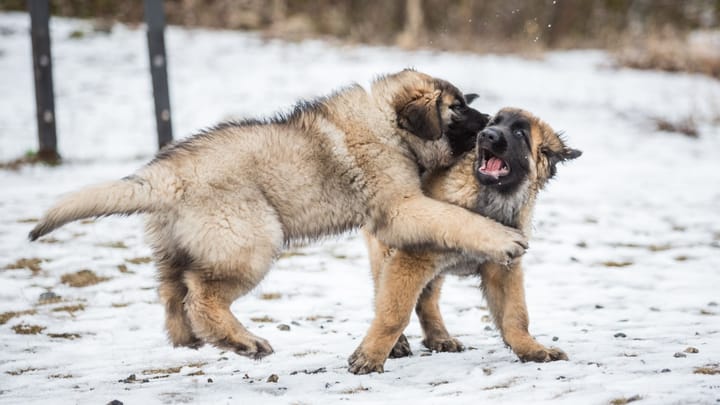Leonberger
Other names : Leonberg, Chien de Leonberg, Leo


The Leonberger, often called the Leo, is a gentle giant known for its loyalty and calm temperament. Originally bred as a guard dog, this mountain breed is also a devoted family companion. Patient with children and typically sociable, the Leonberger remains alert and protective, ready to act if it senses a genuine threat to its loved ones or home.
|
Life expectancy |
The Leonberger has a life expectancy of between 9 and 12 years |
|
Temperament |
|
|
Size |
Large
|
|
Adult size |
Female
Between 26 and 30 in
Male
Between 28 and 31 in
|
|
Adult weight |
Female
Between 99 and 121 lb
Male
Between 121 and 143 lb
|
|
Coat colour
The Leonberger’s coat comes in various shades of fawn, ranging from light to red or dark. It may also appear sandy or any tone between fawn and sand. The muzzle is always black, adding contrast to the overall colouring. |
Sand |
|
Type of coat
The Leonberger has a long, straight coat, though a slight wave is permitted by the breed standard. A dense undercoat provides insulation, while a distinctive mane around the neck and chest adds to the breed’s majestic appearance. |
Long |
|
Eye colour
Their eyes range from light to dark brown. |
Brown
|
|
Purchase price |
The Leonberger costs between £985 and £1220 |
Due to their giant size, breeding can be challenging. Females may experience difficulties conceiving, and whelping is often complicated, sometimes requiring veterinary assistance or caesarean sections. For this reason, responsible breeding is essential, ideally under the guidance of experienced professionals. Additionally, Leonbergers require careful attention during their growth period, including appropriate nutrition and joint care. Their impressive coats require regular grooming, and their large size demands both ample space and a significant commitment. Although robust, they are prone to certain health issues, so choosing a reputable breeder that conducts thorough health screenings is crucial for their long-term well-being.
More details about the Leonberger
Leonberger: Origins and history
The Leonberger is a relatively recent breed, with its origins dating back to 1846 in the town of Leonberg, Germany. The breed was developed by councillor Heinrich Essig, who aimed to create a majestic yet gentle companion dog. He is believed to have crossed a Newfoundland with Saint Bernards and Pyrenean Mountain Dogs to achieve this goal. The result was a large, noble-looking dog with a calm temperament, resembling the lion from Leonberg’s town crest, which may have inspired the breed’s name. Although originally bred as a companion and working dog, the Leonberger soon gained popularity among European nobility. The breed was officially recognised by the Fédération Cynologique Internationale (FCI) in 1955.
Physical characteristics of the Leonberger
The Leonberger is a true giant, muscular yet elegant, with a well-proportioned build and a lively, confident temperament. Its head is moderately arched, with a skull that’s lower and narrower than that of the Saint Bernard, one of the breed’s ancestors. The head appears broad and deep, but without facial wrinkles. The muzzle is slightly deep and never pointed, with a moderate stop and a gently hooked profile. Ears are high-set, drooping, and lie flat against the sides of the head. The legs are strong, straight, and sturdy, while the tail is thick and bushy, carried half-hanging and never curled over the back.
Leonberger: Characteristics
Leonberger: Behaviour
Training a Leonberger
The Leonberger is not a difficult dog to train. Naturally docile and intelligent, they respond well to positive reinforcement and consistent routines. Their strong desire to please, paired with excellent learning ability, makes them highly receptive, especially when training begins early. It’s important to start as soon as the puppy arrives home, establishing clear boundaries and preventing the development of unwanted habits. Early socialisation is equally essential to ensure they grow into a confident, well-mannered adult. While Leonbergers are not aggressive by nature, their sheer size means that poor training or lack of structure can lead to serious challenges. A well-trained Leonberger is a calm and cooperative companion, but achieving that requires commitment from the very beginning.
Leonberger: Lifestyle
Breed compatibility Leonberger
Leonberger: Purchase price
The cost of a Leonberger can vary depending on factors such as lineage, age, and sex, with pedigree puppies averaging around £1,220. In terms of ongoing expenses, expect to budget approximately £60 per month to cover essentials such as food, grooming, and basic healthcare, though this may rise with additional needs or unexpected vet costs.
Leonberger: Shedding
Light
Despite their thick coat, Leonbergers don’t shed excessively year-round. However, during their two annual moulting periods, hair loss becomes much more noticeable. Daily brushing is essential during this time to manage shedding and maintain the coat in good condition.
Leonberger: Grooming
Although the Leonberger’s coat is nearly self-cleaning, it should be brushed at least once a week to prevent matting and preserve its natural beauty and protective qualities. As strong swimmers with pendulous ears, Leonbergers are prone to ear issues, particularly if they swim often. Regular checks and gentle cleaning help prevent infections and keep their ears healthy.
Leonberger: Health
The Leonberger has an average life expectancy of around 9 years, which is typical for giant breeds. While their lifespan may be shorter than that of smaller dogs, good breeding practices, a balanced diet, regular exercise, and routine veterinary care can all contribute to a healthier, more comfortable life into their senior years.
Leonbergers are generally robust and considered one of the hardiest of the giant breeds. They have a strong constitution and good resistance to disease compared to many other large dogs.
Leonbergers do not tolerate heat well, so it’s essential to take precautions during warmer weather. Always provide plenty of fresh water, access to shade, and a cool indoor space. Avoid exercise during the hottest parts of the day, and watch closely for signs of overheating.
Thanks to their thick, dense undercoat, Leonbergers are well protected against the cold and typically enjoy snowy conditions. However, despite their weather-resistant coat, prolonged exposure to rain should be avoided, as dampness can lead to skin issues or discomfort. Ensuring they dry off properly after wet weather is important for maintaining coat and skin health.
Despite their dense coat, a Leonberger’s shape should always remain visible beneath the fur. It’s important to monitor their weight carefully, as excess kilos can put unnecessary strain on their joints and overall health. While it can be hard to resist their pleading eyes, especially as puppies, it’s essential to avoid overfeeding and stick to a balanced, portion-controlled diet.
Like many giant breeds, the Leonberger is prone to certain hereditary and structural conditions. These may include:
- Dilated cardiomyopathy: a heart condition affecting the muscle’s ability to contract properly
- Hip dysplasia: a malformation of the hip joint that can lead to arthritis or mobility issues
- Polyneuropathy: a neurological disorder affecting movement and coordination, sometimes breed-specific
- Gastric dilatation-volvulus (bloat): a life-threatening condition where the stomach twists and fills with gas
- Osteosarcoma: a form of bone cancer more common in large breeds
Regular health checks, responsible breeding, and early screening can help reduce the risk or detect issues early. Let me know if you’d like this section expanded with signs to watch for or preventative care tips.







